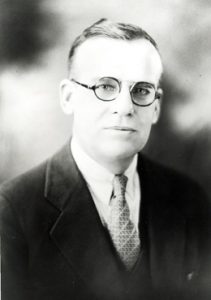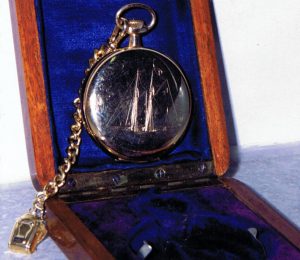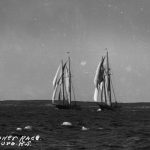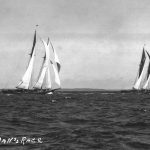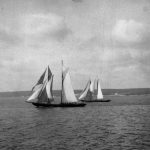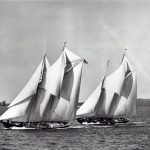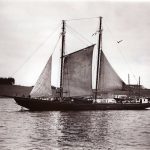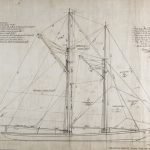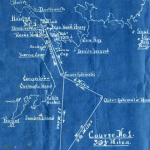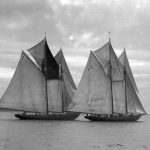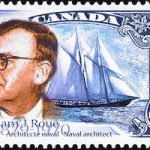Bluenose: A Dartmouth Connection

Featured image is at the launch of ‘Bluenose’ in Lunenburg on March 26, 1921. (Knickles Studio photo. Used with permission)
This Sunday, March 26, marks the 96th anniversary of the launch of the legendary schooner Bluenose, commonly known to be associated with the south shore town of Lunenburg. But do you know she has a Dartmouth connection? A significant one…
Her designer, William James Roué, was a proud Dartmouthian, residing on James Street for more than 60 years.
It was here he lived when he created the magnificent lines of what has been called a perfect schooner, those of Bluenose. At the time he worked in downtown Halifax at the family soda pop manufacturing company, Roué’s Carbonated Waters. He designed Bluenose in off-hours; it was his 17th design and his first schooner. He traveled to Lunenburg often to oversee construction of the vessel as it was the first that renowned shipbuilders Smith and Rhuland had built from an actual design with blueprints and lines that had been placed through mathematical calculations, opposed to a half-hull being used as a guide.
Bluenose was expressly created to beat the Americans who had shamed Canadian east coast fishermen in 1920 when Gloucester, Massachusetts-based Esperanto beat Nova Scotia’s Delawana in the inaugural International Fishermen’s Cup series. Just as important as being a racer, Bluenose needed to be fast in her fishing rig. The ship that got back to port first from the Grand Banks was the one whose crew got the best prices for their catch. She had to earn her way which she did, consistently bringing home the largest catches first. Then in the fall, she recaptured the 1921 International Fishermen’s Cup for Canada by beating the American schooner, Elsie. It was a victory celebrated nationally. Bluenose fever swept the country.
On December 30, 1921, what was then the town of Dartmouth presented Roué with a token of appreciation in the form of a gold pocket watch hand-engraved on the outside with an image of Bluenose and on the inside with script, as well as a plaque which read:
“The Citizens of Dartmouth being proud of the fact that a fellow citizen had the inspiration and courage necessary to undertake the creation of the marvellous “Bluenose”, winner of the International schooner race at Halifax October 24th 1921., take great pleasure in rendering congratulations and wish you know their appreciation of the honor conferred on the town. Words fail to express the pleasure of beholding the result of your handiwork during the elimination races and the grand historical sailing duel with the noble “Elsie” pride of the American fleet. As a slight token of esteem and admiration they ask your kind acceptance of a gift which may be found helpful for timing the speed of future contenders for the International championship.”
While the pop company produced many different varieties it was most well-known for ginger beer/ ginger ale. Soon after the success of Bluenose Roué launched a new ginger ale named Bluenose Ginger Ale. But with the success of Bluenose so too came more requests for custom designs by Roué, so in 1929 at the age of 50 he left the soda pop manufacturing business and became a full-time naval architect.
At first his office was in downtown Halifax but it wasn’t long before he moved it to a studio adjacent to his home on James Street and continued to work until he was well into his 80s, amassing a vast design portfolio of more than 200 vessels with many more built to his specification as often numerous vessels were built from the same design, such as the Bluenose Class Sloop.
Roué’s clients came from all over Canada and the United States, and even overseas – it was for the United Kingdom War Effort that in 1941 he created and designed the sectional barge, a $29 million construction contract that put over 1,000 people back to work at five shipyards in the Maritime provinces, during the war years. These ‘Minca’ barges were among those used to land allied troops on D-Day, and proclaimed by U.S. General Dwight D. Eisenhower to be ‘the best’.
- Bluenose & Elsie, 1921
- Bluenose & Columbia, 1923
- Bluenose & Gertrude L. Thebaud, 1933
- Bluenose & Gertrude L. Thebaud, 1938
- Bluenose in fishing rig, 1922
Above photos copyright Knickles Studio. Used with permission.
Bluenose went on to become the ‘Queen of the North Atlantic’ an undefeated champion in five International competitions, the last of which came in 1938. She worked as a freighter after that and, in 1946, struck a reef off Haiti and sank. Roué’s Bluenose lines were used again in 1963 when a replica, Bluenose II, was built by Oland & Son Breweries, eventually gifted to the Province of Nova Scotia in 1971 just a little more than a year after her creator, then 90, had passed away at his home in Dartmouth.
Bluenose has been on the Canadian dime since 1937 and has been featured on four Canadian postage stamps: 1929, 1955 – with Captain Angus Walters, 1982, and 1998 – with William J. Roué. Roué was included in the ‘Prominent Men of Canada’ publication in 1932, was inducted into the Canadian Sports Hall of Fame in 1955 and was posthumously inducted into the Nova Scotia Sports Hall of Fame in 2004.
- Roue’s Bluenose design (copyright J.E. Roue)
- Halifax Harbour race course, drawn by Roue
- Bluenose & Haligonian, another Roue-design
- Roue’s Minca barges, moored at Westminster
- The 1998 Roue stamp
————————-
William J. Roué’s story and that of Bluenose is told in a book entitled ‘A Spirit Deep Within’ available exclusively at the Dartmouth Heritage Museum Gift Shop, either online or in person.

